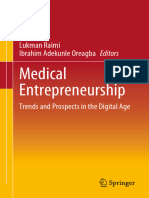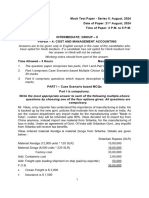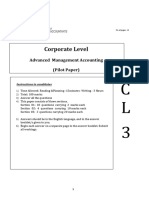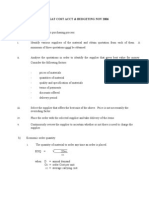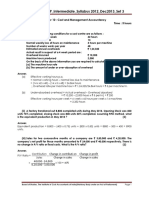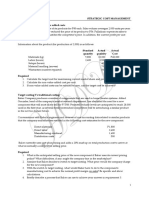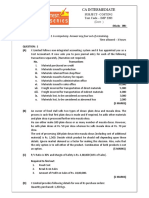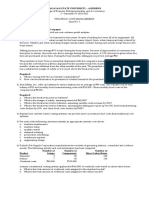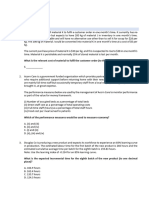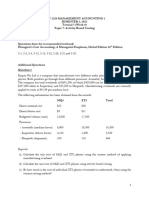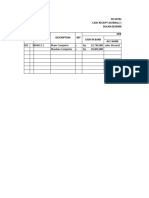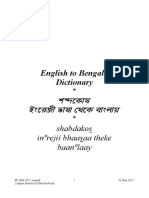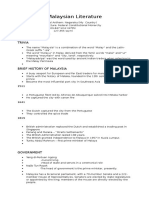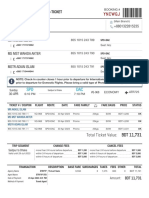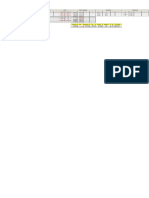CA Inter Cost Q MTP 1 Sept 2024 Exam Castudynotes Com
CA Inter Cost Q MTP 1 Sept 2024 Exam Castudynotes Com
Uploaded by
sarthakgupta171205Copyright:
Available Formats
CA Inter Cost Q MTP 1 Sept 2024 Exam Castudynotes Com
CA Inter Cost Q MTP 1 Sept 2024 Exam Castudynotes Com
Uploaded by
sarthakgupta171205Copyright
Available Formats
Share this document
Did you find this document useful?
Is this content inappropriate?
Copyright:
Available Formats
CA Inter Cost Q MTP 1 Sept 2024 Exam Castudynotes Com
CA Inter Cost Q MTP 1 Sept 2024 Exam Castudynotes Com
Uploaded by
sarthakgupta171205Copyright:
Available Formats
Downloaded From www.castudynotes.
com
Mock Test Paper - Series I: July, 2024
Date of Paper: 1st August, 2024
Time of Paper: 2 P.M. to 5 P.M.
INTERMEDIATE: GROUP – II
PAPER – 4: COST AND MANAGEMENT ACCOUNTING
Answers are to be given only in English except in the case of the candidates who
have opted for Hindi medium. If a candidate has not opted for Hindi medium his/
her answer in Hindi will not be valued.
Working notes should form part of the answer.
Time Allowed – 3 Hours Maximum Marks – 100
1. The question paper comprises two parts, Part I and Part II.
2. Part I comprises Case Scenario based Multiple Choice Questions (MCQs) for
30 marks
3. Part II comprises questions which require descriptive type answers for 70
marks.
PART I – Case Scenario based MCQs
Part I is compulsory.
Write the most appropriate answer to each of the following multiple-choice
questions by choosing one of the four options given. All questions are
compulsory.
Tropic Pvt Ltd was engaged in the business of manufacturing Product P. The
product P required 2 units of Material R. The company intends to sell 24,000 units
of Product P and does not wish to retain any closing stock. However the opening
stock of Product P is 4,000 units. Raw Material R has to be procured after
considering the opening stock of R amounting to 10,000 units. The technical team
further confirms that the yield in the course of manufacture of Product P is 80% of
the input.
The company presently procures its annual requirement of materials on a quarterly
basis from its regular supplier enjoying a discount of 2.5% on the invoice price of
the material of ` 20 per unit. Every time the company places orders for Material R,
it incurs ` 125 for each of the order placed. The company also has taken a rented
warehouse for storing material R and the annual cost of storage is ` 10 per unit.
The company appointed Mr. T a Chartered Accountant to review the cost of
inventory and provide measures of improvement of cost. After reviewing the
material purchase and consumption pattern, Mr. T suggested that the
implementation of Wilson’s EOQ would be beneficial to the company. He
emphasized that the change in the quantity ordered would result in reduction of
inventory carrying costs.
Join Us on Telegram http://t.me/canotes_ipcc
Downloaded From www.castudynotes.com
Mr. T further reviewed the labour costing and identified that the employees were
paid overtime wages to ensure timely completion of projects. Overtime wages
comprised of daily wage and 100% of daily wages as overtime premium. Based on
the cost record it was understood that every month had 180 hours of regular
working hours which was remunerated at ` 200 per hour and Overtime of 20 hours
which was remunerated at ` 400 per hour. Mr. T suggested that the above time
taken may be considered as standard and a scheme of Incentive be introduced to
reduce overtime cost. He further indicated that Rowan scheme of incentive be used
to measure performance and the improved productivity per hour would be 125 units
per hour.
In this regard, address the following queries in line with the suggestions provided
by Mr. T to Tropic Pvt Ltd.
1. The annual requirement of Material R to meet the target sales of 24,000 units
of Product P is:
(a) 48,000 units
(b) 60,000 units
(c) 40,000 units
(d) 50,000 units
2. The ordering quantity as per the current inventory policy and the proposed
Wilson’s Economic order quantity of Material R are:
(a) Order Quatity as per the current inventory policy – 10,000 units &
Economic Order Quantity – 1,000 units
(b) Order Quantity as per the current inventory policy – 15,000 units &
Economic Order Quantity – 1,225 units
(c) Order Quantity as per the current inventory policy – 12,000 units &
Economic Order Quantity – 1,095 units
(d) Order Quantity as per the current inventory policy – 12,500 units &
Economic Order Quantity – 1,118 units
3. The net savings to inventory cost on migration from the current inventory
policy to the Wilson’s Economic Order Quantity policy would be:
(a) Savings from EOQ as compared to current discount policy –
` 26,820
(b) Savings from EOQ as compared to current discount policy –
` 20,500
(c) Savings from EOQ as compared to current discount policy –
` 33,253
(d) Savings from EOQ as compared to current discount policy –
` 25,546
Join Us on Telegram http://t.me/canotes_ipcc
Downloaded From www.castudynotes.com
4. Incentive payable under the Rowan Incentive scheme amounts to:
(a) ` 7,500
(b) ` 6,400
(c) ` 6,000
(d) ` 8,000
5. The savings in labour cost achieved by implementation of incentive scheme
over the overtime payments amounts to:
(a) ` 9,600
(b) ` 5,600
(c) ` 8,000
(d) ` 3,200 (5 x 2 = 10 Marks)
XYZ Manufacturing Pvt. Ltd. is a prominent company in the electric appliances
industry, known for producing a diverse range of high-quality products. The
company has built a reputation for reliability and innovation in the manufacturing of
household appliances, including fans, mixers, and heaters. XYZ Manufacturing Pvt.
Ltd. is dedicated to delivering products that meet the needs of its customers while
adhering to the highest standards of quality and performance.
The company operates a state-of-the-art factory that is fully equipped with
advanced machinery and technology to ensure efficient and consistent production.
The factory operates 25 days a month, running multiple shifts to meet the growing
demand for its products. The company have spare capacity to additional orders.
Each product type—fans, mixers, and heaters—undergoes a meticulous
manufacturing process that includes assembly, quality testing, and packaging.
Cost Category Amount (`)
Fixed Costs (per month)
Factory Rent ` 3,00,000
Depreciation ` 2,00,000
Administrative Expenses ` 1,00,000
Salaries ` 4,00,000
Total Fixed Costs ` 10,00,000
Number of units produced per month 10,000 units
(Note: Last month there was an additional special order of
2000 units which resulted in higher production)
Selling price per unit ` 1,500
Additional Info: Raw Materials include Copper, Plastic, and Other Materials. The
per unit cost of Copper is ` 80 more than the cost of Plastic, while the cost of Other
Materials is twice that of Plastic. And the total Raw Material Cost per unit is ` 210
more than the combined cost of Copper & Plastic.
3
Join Us on Telegram http://t.me/canotes_ipcc
Downloaded From www.castudynotes.com
The Labour Hour Rate is ` 100 per hour. The total labour hours used in the last
month were 36,000 Hours. The Utilities Cost per unit is ` 100, and the Packaging
Cost per unit is ` 50. Being a finance manager of the company, you are required to
answer the following:
6. Calculate the contribution margin per unit.
(a) ` 550
(b) ` 600
(c) ` 650
(d) ` 700
7. Determine the break-even point in sales revenue.
(a) ` 31,28,593
(b) ` 25,85,153
(c) ` 27,27,025
(d) ` 27,05,983
8. If the company wants to achieve a target profit of ` 5,00,000, what should be
the sales volume (in units)?
(a) 2,000 units
(b) 2,727 units
(c) 2,750 units
(d) 3,000 units
9. What would be the impact on the break-even point if the variable cost per unit
increases by 10%?
(a) 2,178 units
(b) 2,198 units
(c) 2,248 units
(d) 2,258 units
10. Calculate the margin of safety in percentage if the company sells 4,000 units
if the variable cost per unit increases by 10%
(a) 44.85%
(b) 42.55%
(c) 45.05%
(d) 45.75% (5 x 2 = 10 Marks)
11. A FMCG company has an annual demand of 50,000 units for its specific
product whose setting up cost per batch is ` 10,000 and carrying cost per unit
per month is ` 1. What is the Economic Batch Quantity?
4
Join Us on Telegram http://t.me/canotes_ipcc
Downloaded From www.castudynotes.com
(a) 7,071 units
(b) 10,000 units
(c) 12,641 units
(d) 9,129 units (2 Marks)
12. A furniture company uses premium wood for sofa. Standard quantity of
premium wood per sofa is 5 sq. ft. Standard price per sq. ft. of premium wood
is ` 10. Actual production of sofa is 1,000. Premium wood actually used is
5,300 sq. ft. Actual purchase price of premium wood per sq. ft. is ` 10. What
is material cost variance?
(a) ` 3,000 (A)
(b) ` 4,300 (A)
(c) ` 7,300 (A)
(d) ` 5,300 (F) (2 Marks)
13. One of Pintu Company’s cost pools is parts administration. The budgeted
overhead cost for that cost pool was ` 4,00,000 and the expected activity was
4,000 part types. The actual overhead cost for the cost pool was ` 4,20,000
at an actual activity of 5,000 part types. The activity rate for that cost pool
was:
(a) ` 80 per part type
(b) ` 100 per part type
(c) ` 105 per part type
(d) ` 84 per part type (2 Marks)
14. A truck carrying 10 tons of goods over 200 kilometres per day for 26 days in
a month. The ton kms applicable is -
(a) 52,000
(b) 20,000
(c) 5200
(d) 260 (2 Marks)
15. Standard hours required for doing a work is 100 hours and budgeted hours is
120 hrs while the same work is actually completed by workers in 110 hrs. You
are required to calculate the activity ratio:
(a) 109.09%
(b) 83.33%
(c) 90.90%
(d) 110% (2 Marks)
Join Us on Telegram http://t.me/canotes_ipcc
Downloaded From www.castudynotes.com
PART-II – Descriptive Questions (70 Marks)
Question No. 1 is compulsory.
Attempt any four questions out of the remaining five questions.
1. (a) From the following data of Meta Ltd., CALCULATE Cost of production:
Amount
(`)
(i) Repair & maintenance paid for plant & 9,80,500
machinery
(ii) Insurance premium paid for inventories 26,000
(iii) Insurance premium paid for plant & machinery 96,000
(iv) Raw materials purchased 64,00,000
(v) Opening stock of raw materials 2,88,000
(vi) Closing stock of raw materials 4,46,000
(vii) Wages paid 23,20,000
(viii) Value of opening Work-in-process 4,06,000
(ix) Value of closing Work-in-process 6,02,100
(x) Quality control cost for the products in 86,000
manufacturing process
(xi) Research & development cost for improvement 92,600
in production process
(xii) Administrative cost for:
- Factory & production 9,00,000
- Others 11,60,000
(xiii) Amount realised by selling scrap generated 9,200
during the manufacturing process
(xiv) Packing cost necessary to preserve the goods 10,200
for further processing
(xv) Salary paid to Director (Technical) 8,90,000
(xvi) Expenses paid for pollution control and 22,000
engineering & maintenance
(5 Marks)
(b) A manufacturing company has disclosed net loss of ` 48,700 as per their
cost accounting records for the year ended 31 st March, 2024. However
their financial accounting records disclosed net profit of ` 30,400 for the
same period. A scrutiny of data of both the sets of books of accounts
revealed the following informations:
`
(i) Factory overheads under absorbed 30,500
(ii) Administrative overheads over absorbed 65,000
Join Us on Telegram http://t.me/canotes_ipcc
Downloaded From www.castudynotes.com
(iii) Depreciation charged in financial accounts 2,25,000
(iv) Depreciation charged in cost accounts 2,70,000
(v) Income-tax provision 52,400
(vi) Transfer fee (credited in financial accounts) 10,200
(vii) Obsolescence loss charged in financial 20,700
accounts
(viii) Notional rent of own premises charged in 49,000
cost accounts
(ix) Value of opening stock:
(a) in cost accounts 1,38,000
(b) in financial accounts 1,15,000
(x) Value of closing stock:
(a) in cost accounts 1,22,000
(b) in financial accounts 1,12,500
PREPARE a Memorandum Reconciliation Account by taking costing loss
as base. (5 Marks)
(c) A job can be executed either through workman A or B. A takes 32 hours
to complete the job while B finishes it in 30 hours. The standard time to
finish the job is 40 hours.
The hourly wage rate is same for both the workers. In addition workman
A is entitled to receive bonus according to Halsey plan (50%) sharing
while B is paid bonus as per Rowan plan. The works overheads are
absorbed on the job at ` 7.50 per labour hour worked. The factory cost
of the job comes to ` 2,200 irrespective of the workman engaged.
FIND out the hourly wage rate and cost of raw materials input. Also
SHOW cost against each element of cost included in factory cost.
(4 Marks)
2. (a) PQR Company Ltd. provides the following information relating to
Process-P:
(i) Opening Work-in-progress - NIL
(ii) Units Introduced - 45,000 units @ ` 10 per unit
(iii) Expenses debited to the process:
Direct material ` 65,500
Labour ` 90,800
Overhead ` 1,80,700
(iv) Normal loss in the process - 2% of Input
Join Us on Telegram http://t.me/canotes_ipcc
Downloaded From www.castudynotes.com
(v) Work-in progress - 1800 units
Degree of completion
Materials - 100%
Labour - 50%
Overhead - 40%
(vi) Finished output - 42,000 units
(vii) Degree of completion of abnormal loss:
Materials - 100%
Labour - 80%
Overhead - 60%
(viii) Units scrapped as normal loss were sold at ` 5 per unit.
(ix) All the units of abnormal loss were sold at ` 2 per unit.
You are required to PREPARE:
➢ Statement of equivalent production.
➢ Statement showing the cost of finished goods, abnormal loss and
closing balance of work-in-progress.
➢ Process-P account and abnormal loss account. (10 Marks)
(b) EXPLAIN the treatment of following items in cost sheet.
(i) Credit for Recoveries
(ii) Packing Cost (primary)
(iii) Joint Products and By-Products
(iv) Quality Control Cost (4 Marks)
3. (a) A company manufactures one main product (MN) and two by-products
AB and PQ. For the month of January 2024, following details are
available:
Total Cost upto separation Point ` 2,12,400
MN AB PQ
Cost after separation - ` 35,000 ` 24,000
No. of units produced 4,000 1,800 3,000
Selling price per unit ` 100 ` 40 ` 30
Estimated net profit as percentage to - 20% 30%
sales value
Estimated selling expenses as 30% 15% 15%
percentage to sales value
8
Join Us on Telegram http://t.me/canotes_ipcc
Downloaded From www.castudynotes.com
There are no beginning or closing inventories.
PREPARE statement showing:
(i) Allocation of joint cost; and
(ii) Product-wise and overall profitability of the company for January
2024. (6 Marks)
(b) A mini-bus, having a capacity of 32 passengers, operates between two
places - 'A' and 'B'. The distance between the place 'A' and place 'B' is
30 km. The bus makes 10 round trips in a day for 25 days in a month.
On an average, the occupancy ratio is 70% and is expected throughout
the year.
The details of other expenses are as under:
Amount (`)
Insurance 15,600 Per annum
Garage Rent 2,400 Per quarter
Road Tax 5,000 Per annum
Repairs 4,800 Per quarter
Salary of operating staff 7,200 Per month
Tyres and Tubes 3,600 Per quarter
Diesel: (one litre is consumed for every 5 km) 13 Per litre
Oil and Sundries 22 Per 100 km run
Depreciation 68,000 Per annum
Passenger tax @ 22% on total taking is to be levied and bus operator
requires a profit of 25% on total taking.
PREPARE operating cost statement on the annual basis and find out the
cost per passenger kilometer and one way fare per passenger.
(8 Marks)
4. (a) The following particulars refer to process used in the treatment of
material subsequently, incorporated in a component forming part of an
electrical appliance:
(i) The original cost of the machine used (Purchased in June 2023)
was ` 10,000. Its estimated life is 10 years, the estimated scrap
value at the end of its life is ` 1,000, and the estimated working time
per year (50 weeks of 44 hours) is 2,200 hours of which machine
maintenance etc., is estimated to take up 200 hours.
No other loss of working time expected. Setting up time, estimated
at 100 hours, is regarded as productive time. (Holiday to be
ignored).
9
Join Us on Telegram http://t.me/canotes_ipcc
Downloaded From www.castudynotes.com
(ii) Electricity used by the machine during production is 16 units per
hour at cost of a 9 paisa per unit. No current is taken during
maintenance or setting up.
(iii) The machine required a chemical solution which is replaced at the
end of week at a cost of ` 20 each time.
(iv) The estimated cost of maintenance per year is ` 1,800.
(v) Two attendants control the operation of machine together with five
other identical machines. Their combined weekly wages, insurance
and the employer's contribution to holiday pay amount ` 120.
(vi) Departmental and general works overhead allocated to this
machine for the current year amount to ` 3,000.
You are required to CALCULATE the machine hour rate of operating the
machine. (6 Marks)
(b) Anju Limited produces a product 'Pect' which is sold in a 10 Kg. packet.
The standard cost card per packet of 'Pect' are as follows:
`
Direct materials 10 kg @ ` 45 per kg 450
Direct labour 8 hours @ ` 50 per hour 400
Variable Overhead 8 hours @ ` 10 per hour 80
Fixed Overhead 200
1,130
Budgeted output for the third quarter of a year was 10,000 Kg. Actual
output is 9,000 Kg.
Actual cost for this quarter are as follows :
`
Direct Materials 8,900 Kg @ ` 46 per Kg. 4,09,400
Direct Labour 7,000 hours @ ` 52 per hour 3,64,000
Variable Overhead incurred 72,500
Fixed Overhead incurred 1,92,000
You are required to CALCULATE:
(i) Material Usage Variance
(ii) Material Price Variance
(iii) Material Cost Variance
(iv) Labour Efficiency Variance
(v) Labour Rate Variance
10
Join Us on Telegram http://t.me/canotes_ipcc
Downloaded From www.castudynotes.com
(vi) Labour Cost Variance
(vii) Variable Overhead Cost Variance
(viii) Fixed Overhead Cost Variance (8 Marks)
5. (a) Bicon Ltd. manufactures two products using two types of materials and
one grade of labour. Shown below is an extract from the company’s
working papers for the next month’s budget:
Product - A Product-B
Budgeted sales (in units) 2,400 3,600
Budgeted material consumption per
unit (in kg):
Material-X 5 3
Material-Y 4 6
Standard labour hours allowed per
3 5
unit of product
Material-X and Material-Y cost ` 4 and ` 6 per kg and labours are paid
` 25 per hour. Overtime premium is 50% and is payable, if a worker
works for more than 40 hours a week. There are 180 direct workers.
The target productivity ratio (or efficiency ratio) for the productive hours
worked by the direct workers in actually manufacturing the products is
80%. In addition the non-productive down-time is budgeted at 20% of the
productive hours worked.
There are four 5-days weeks in the budgeted period and it is anticipated
that sales and production will occur evenly throughout the whole period.
It is anticipated that stock at the beginning of the period will be:
Product-A 400 units
Product-B 200 units
Material-X 1,000 kgs.
Material-Y 500 kgs.
The anticipated closing stocks for budget period are as below:
Product-A 4 days sales
Product-B 5 days sales
Material-X 10 days consumption
Material-Y 6 days consumption
Required:
CALCULATE the Material Purchase Budget and the Wages Budget for
the direct workers, showing the quantities and values, for the next month.
(7 Marks)
11
Join Us on Telegram http://t.me/canotes_ipcc
Downloaded From www.castudynotes.com
(b) Icecold a FMCG Company manufactures and sells three flavors of ice
cream:
Dark chocolate, Chocolate, and Butterscotch. The batch size for the ice
cream is limited to 1,000 ice cream based on the size of the fridge and
ice cream molds owned by the company. Based on budgetary
projections, the information listed below is available:
Dark chocolate Chocolate Butterscotch
Projected sales in units 500,000 800,000 600,000
PER UNIT data:
Selling price ` 80 ` 75 ` 60
Direct materials ` 20 ` 15 ` 14
Direct labor `4 `2 `2
Hours per 1000-unit batch:
Direct labor hours 20 10 10
Fridge hours 1 1 1
Packaging hours 0.5 0.5 0.5
Total overhead costs and activity levels for the year are estimated as follows:
Activity Overhead costs Activity levels
Direct labor 2,400 hours
Fridge ` 2,10,00,000 1,900 fridge hours
Packaging ` 1,50,00,000 950 packaging hours
` 3,60,00,000
Required:
a. With the help of ABC system, for the Chocolate ice cream:
1. Compute the activity-cost-driver rate
2. Compute the estimated overhead costs per thousand ice cream.
3. Compute the estimated operating profit per thousand ice cream.
b. With the help of traditional system (with direct labor hours as the
overhead allocation base), for the Chocolate ice cream, compute
the estimated operating profit per thousand ice cream. (7 Marks)
6. (a) EXPLAIN the types of responsibility centres. (5 Marks)
(b) EXPLAIN the efficiency rating procedures of the employees. (5 Marks)
(c) WHAT are the essential pre-requisites for integrated accounts?(4 Marks)
OR
(d) WHAT are the principles of estimation of costs and benefits? (4 Marks)
12
Join Us on Telegram http://t.me/canotes_ipcc
You might also like
- PM Sect B Test 6Document5 pagesPM Sect B Test 6FarahAin FainNo ratings yet
- SB 1289a NavajoDocument7 pagesSB 1289a NavajoDiego LlNo ratings yet
- Lukman Raimi, Ibrahim Adekunle Oreagba - Medical Entrepreneurship - Trends and Prospects in The Digital Age-Springer (2023)Document380 pagesLukman Raimi, Ibrahim Adekunle Oreagba - Medical Entrepreneurship - Trends and Prospects in The Digital Age-Springer (2023)ashwarsamirNo ratings yet
- Chapter 4 QuestionsDocument8 pagesChapter 4 Questionsreicelle vejerano100% (1)
- Midterm Quiz 2 - Problem and Answer KeyDocument6 pagesMidterm Quiz 2 - Problem and Answer KeyRynette Flores100% (1)
- CostingDocument214 pagesCostingchiknvakumarNo ratings yet
- MTP 26 51 Questions 1722429342Document12 pagesMTP 26 51 Questions 1722429342tp.extraworkNo ratings yet
- CA-Inter-Cost-Q-MTP-2-Sept-2024-Exam-castudynotes-comDocument12 pagesCA-Inter-Cost-Q-MTP-2-Sept-2024-Exam-castudynotes-comkarnimasoni12No ratings yet
- CA Inter Costing Q MTP 1 May 2024 Castudynotes ComDocument11 pagesCA Inter Costing Q MTP 1 May 2024 Castudynotes ComGaurav kothariNo ratings yet
- MCQ 1Document5 pagesMCQ 1Aashik cgNo ratings yet
- MTP 17 51 Questions 1710158898Document11 pagesMTP 17 51 Questions 1710158898Naveen R HegadeNo ratings yet
- MTP-S2-P4-SEP24Document12 pagesMTP-S2-P4-SEP24amanmalik1517No ratings yet
- CA-Inter Jan 25 - Costing - Full TestDocument9 pagesCA-Inter Jan 25 - Costing - Full Testvso04gj8pkNo ratings yet
- For Revision - Practice Qs - Open TuitionDocument28 pagesFor Revision - Practice Qs - Open TuitionvuongmoctaNo ratings yet
- Ma QPDocument15 pagesMa QPBijay AgrawalNo ratings yet
- VM Costing ImpDocument22 pagesVM Costing ImpSinsNo ratings yet
- Cost Management Accounting Full Test 1 Nov 2023 Test Paper 1689158389Document17 pagesCost Management Accounting Full Test 1 Nov 2023 Test Paper 1689158389ahanaghosal2022No ratings yet
- Unit V - QuestionsDocument4 pagesUnit V - QuestionsLeemaRosaline SimonNo ratings yet
- Practice Sheet 12 - EOQ SolutionDocument9 pagesPractice Sheet 12 - EOQ Solutionmusfat016No ratings yet
- CA Inter Costing RTP Sept 2024 Exam Castudynotes ComDocument38 pagesCA Inter Costing RTP Sept 2024 Exam Castudynotes ComAditya YadavNo ratings yet
- Gat Cost Acct Nov 2006Document10 pagesGat Cost Acct Nov 2006samuel_dwumfourNo ratings yet
- 81159bos65352 p4Document38 pages81159bos65352 p4ajay singhNo ratings yet
- Material Cost QuestionsDocument2 pagesMaterial Cost Questionskarnimasoni12No ratings yet
- Paper 4Document17 pagesPaper 4HARSHITH C NNo ratings yet
- Cost Management Accounting Full Test 1 May 2024 Test Paper 1708155256Document24 pagesCost Management Accounting Full Test 1 May 2024 Test Paper 1708155256Siddharth NathanNo ratings yet
- First Time Login Guide MsDocument6 pagesFirst Time Login Guide MskonosubaNo ratings yet
- 16-500 Mcqs of Fundamentals of Accounting PDF For All ExamsDocument50 pages16-500 Mcqs of Fundamentals of Accounting PDF For All ExamsQasim AliNo ratings yet
- Question - Parallel Quiz - Final Term - Cost Accounting 22 - 23Document6 pagesQuestion - Parallel Quiz - Final Term - Cost Accounting 22 - 23Gistima Putra JavandaNo ratings yet
- Department of Accounting and Information SystemDocument8 pagesDepartment of Accounting and Information SystemLabib SafeenNo ratings yet
- PM Sunway Test July-Sept 2023 PTDocument11 pagesPM Sunway Test July-Sept 2023 PTFarahAin FainNo ratings yet
- Cost 2014Document3 pagesCost 2014Mozam MushtaqNo ratings yet
- Paper10 SolutionDocument19 pagesPaper10 SolutionKamal KumarNo ratings yet
- Tutorial Questions: Pricing DecisionDocument5 pagesTutorial Questions: Pricing Decisionmarlina rahmatNo ratings yet
- 2019 Strategic Cost Management QaDocument7 pages2019 Strategic Cost Management QaIrra May GanotNo ratings yet
- 30784rtpfinalnov2013 5Document0 pages30784rtpfinalnov2013 5kamlesh1714No ratings yet
- AMA End Term QPDocument6 pagesAMA End Term QPmaneesh15dNo ratings yet
- Cost Mock Test Paper 2Document7 pagesCost Mock Test Paper 2Soul of honeyNo ratings yet
- Imp 2203 - Costing - Question PaperDocument5 pagesImp 2203 - Costing - Question PaperAnshit BahediaNo ratings yet
- Topic 2 Cost Concepts and Analysis HandoutsDocument5 pagesTopic 2 Cost Concepts and Analysis HandoutsJohn Kenneth ColarinaNo ratings yet
- Test No. 3Document4 pagesTest No. 3RAMASUBRAMANIAN SANKARNo ratings yet
- CA P. E. II Course PE II Exam Revision Test Papers NovembeDocument25 pagesCA P. E. II Course PE II Exam Revision Test Papers Novembeakash yadavNo ratings yet
- All Chapters Practical QuestionsDocument14 pagesAll Chapters Practical QuestionsNarayan choudharyNo ratings yet
- Part A: Managerial Accounting Assessment - ACC720 - March 2020Document4 pagesPart A: Managerial Accounting Assessment - ACC720 - March 2020Helmy Yusoff100% (1)
- Process CostingDocument18 pagesProcess CostingCheliah Mae ImperialNo ratings yet
- Cagayan State University - AndrewsDocument4 pagesCagayan State University - AndrewsWynie AreolaNo ratings yet
- Chapter 4 QuestionsDocument8 pagesChapter 4 Questionsfrieda20093835No ratings yet
- Tentative Suggested Answer - Nov. 22 ExamDocument20 pagesTentative Suggested Answer - Nov. 22 ExamHemant RathvaNo ratings yet
- REVIEW QUESTIONS MaterialsDocument4 pagesREVIEW QUESTIONS Materialsdismas malekelaNo ratings yet
- Section C Part 2 MCQDocument344 pagesSection C Part 2 MCQSaiswetha Bethi100% (1)
- Solution CMA January 2022 ExaminationDocument6 pagesSolution CMA January 2022 ExaminationKamrul HassanNo ratings yet
- Examiner's ReportDocument50 pagesExaminer's ReportTriple ONo ratings yet
- Exam 21082011Document8 pagesExam 21082011Rabah ElmasriNo ratings yet
- Cost 2023-MayDocument6 pagesCost 2023-MayDAVID I MUSHINo ratings yet
- Tutorial 4Document6 pagesTutorial 4FEI FEINo ratings yet
- De 4 F 2Document7 pagesDe 4 F 2Quỳnh QuỳnhNo ratings yet
- Syllabus12 - Dec2014 - P8 CostDocument14 pagesSyllabus12 - Dec2014 - P8 Costrjrohit793No ratings yet
- CA Inter Cost and Management Accounting - Answer Key 1Document34 pagesCA Inter Cost and Management Accounting - Answer Key 1Aishwarya NaiduNo ratings yet
- Tutorial Question Topic 7Document3 pagesTutorial Question Topic 7p4accaNo ratings yet
- 102.COAP - .L I Question CMA Special Examination 2021novemberDocument4 pages102.COAP - .L I Question CMA Special Examination 2021novemberleyaketjnuNo ratings yet
- D) Ending Work in Process Is Less Than The Amount of The Beginning Work in Process InventoryDocument9 pagesD) Ending Work in Process Is Less Than The Amount of The Beginning Work in Process InventoryPhương Thảo HoàngNo ratings yet
- NAME: Jessica Liew Jia Yi (2019000219) Tutorial Chapter 5: Competitor AnalysisDocument3 pagesNAME: Jessica Liew Jia Yi (2019000219) Tutorial Chapter 5: Competitor AnalysisjessicaNo ratings yet
- Fate:: Major ThemesDocument3 pagesFate:: Major ThemesHydz Deus Meus ConfugerunNo ratings yet
- About The AisinDocument8 pagesAbout The AisinSamuel YoungNo ratings yet
- Sarada WalkthroughDocument9 pagesSarada WalkthroughScribdTranslationsNo ratings yet
- PD Mitra Cash Receipt Journal (Meizha Zhahra) Bulan Desember 2016 Debit Cash in Bank Other Acc NameDocument7 pagesPD Mitra Cash Receipt Journal (Meizha Zhahra) Bulan Desember 2016 Debit Cash in Bank Other Acc NameMeizha ZhahraNo ratings yet
- Summer Holidays' Assignments - Class 12THDocument19 pagesSummer Holidays' Assignments - Class 12THpalakNo ratings yet
- Hackbart vs. City of Pittsburgh - Flipping Off A Police Officer and Saying FU Is LegalDocument19 pagesHackbart vs. City of Pittsburgh - Flipping Off A Police Officer and Saying FU Is LegalijostlNo ratings yet
- DittophobiaDocument7 pagesDittophobialeandromesa010No ratings yet
- Leadership Style: Managing Career at BarcaDocument2 pagesLeadership Style: Managing Career at BarcaDheer PawarNo ratings yet
- Mohammed Fasi Ahmed - CVDocument3 pagesMohammed Fasi Ahmed - CVmjnasar khan jamalNo ratings yet
- APGVB Job Notification For Officer and Office Assistant PostsDocument9 pagesAPGVB Job Notification For Officer and Office Assistant PostsCareerNotifications.comNo ratings yet
- Dashboard Test Script (Am)Document6 pagesDashboard Test Script (Am)Anonymous rrgwHzyqGNo ratings yet
- Ancient System of Town Planning in IndiaDocument42 pagesAncient System of Town Planning in Indialakshmanan_ct96% (23)
- Industrial Training Fund: Students Industrial Work Experience Scheme End of Year Programreport SheetDocument2 pagesIndustrial Training Fund: Students Industrial Work Experience Scheme End of Year Programreport Sheetjessica Emmanuel100% (1)
- Minutes of The Meeting-7th Regular SessionDocument2 pagesMinutes of The Meeting-7th Regular SessionEdlyn Ria AlisboNo ratings yet
- Personal Best A1 Unit 1 Grammar TestDocument2 pagesPersonal Best A1 Unit 1 Grammar Testjavier raul GarciaNo ratings yet
- EnterprenuerDocument3 pagesEnterprenuersk77*No ratings yet
- English To Bengali DictionaryDocument649 pagesEnglish To Bengali DictionarySurajit Biswas100% (2)
- Ramaswamy PDocument29 pagesRamaswamy PVANSH 1No ratings yet
- Malaysian LiteratureDocument8 pagesMalaysian LiteratureErica Lee100% (2)
- Brindavan Public School: Application For RegistrationDocument1 pageBrindavan Public School: Application For RegistrationvenuedNo ratings yet
- AircraftDocument68 pagesAircraftaqil_shamsi0% (1)
- NOVOAIR - View ReservationDocument2 pagesNOVOAIR - View ReservationAsif IslamNo ratings yet
- P.Y Question Paper Income Tax Delhi UniversityDocument5 pagesP.Y Question Paper Income Tax Delhi UniversityHarsh chetiwal50% (2)
- Issues in The Teach NG NoteDocument6 pagesIssues in The Teach NG NoteShivam Arora0% (1)
- Daniel Doc Final 2Document14 pagesDaniel Doc Final 2demessieyimer88No ratings yet
- MCQ On Art and CultureDocument41 pagesMCQ On Art and CultureurhanNo ratings yet
- 256-Article Text-594-1-10-20180302Document5 pages256-Article Text-594-1-10-20180302Hery PurnawantNo ratings yet


